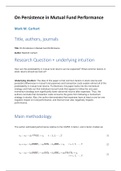Summary
Extensive Summary - On Persistence in Mutual Fund Performance Mark M. Carhart
- Module
- Institution
This is an extensive summary. In this summary you can find a sentence or two about each graph and figure based on the authors conclusion. I took just what was important to know about the article. Section V is not included.
[Show more]



